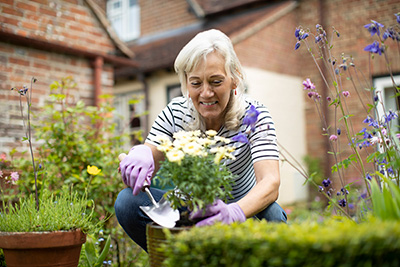
There’s been a lot of talk about gardening on social media and in the news recently as most Americans have been spending a significant portion of their time at home. A home garden is also a great way to provide you and your family with fresh, local food. This is especially important when stores are out of some food selections and when going out shopping is difficult for so many people.
Gardening can have another benefit as well: exercise.
While not all gardening activities can count as exercise, there certainly are many parts of it that can build muscles and burn calories. Starting a garden can require a lot of digging, raking, spading, lifting, shoveling, and depending on the size of your garden even building. But even if you are starting a small pot garden (think herbs or a tomato plant), you will likely have to lift and carry big bags of soil. If you are starting a garden in your yard from scratch, the initial set up may take you a few days or even weeks to complete. That’s ok. Pace yourself and know that the hard work you are doing is exercise. While the calories you burn gardening will depend on what exactly you are doing, according to WebMD gardening can expend between 200-400 calories per hour.
Once your garden is planted, maintaining it will also require exercise. You’ll have to spend time weeding, pruning, watering, and walking. Walking through your garden daily can also help burn some calories. Every little bit of exercise adds up. Even harvesting will require walking and carrying potentially heavy loads (if your garden successfully produces).
If you have been cleared to exercise after your gastric sleeve, gastric bypass, or lap band surgery by Dr. Shillingford, MD, or your bariatric surgeon, you can begin working on your garden slowly. Just like any new workout program, start with small steps to make sure your post surgical body can handle the activity. Try to distribute the load evenly between both hands. Even if you are right handed, shift the shovel or rake to utilize your left arm to make sure you give those muscles so work too. Bags of soil or mulch can be heavy. Remember to lift with your legs, not your back. Bring a drink with you to sip your water (or non-caloric drink) as you go. If you are working outside in the sun, you will have to pay extra attention to your hydration as bariatric patients have a higher risk of dehydration.
Gardening can be great exercise and it can help you focus on eating more vegetables. Whether you grow cucumbers, peppers, tomatoes, avocados, green beans, lettuce, mint, arugula, radishes, lemons, cabbage, or microgreens, you are more likely to eat the fruits or vegetables if you grow them yourself. While protein should be the first priority for gastric sleeve, gastric bypass, and lap band patients, eating vegetables should be their second priority once they have reached that stage in their post op bariatric diet. Vegetables are packed with vitamins and minerals, and many vegetables have a low carbohydrate content making them ideal for weight loss surgery patients.
For more exercise and nutrition tips, “Like” Dr. Shillingford’s Facebook page and Pinterest boards. You can also check his blogs regularly for recipes, tips, and motivation. Dr. Shillingford, MD, PA, is a board-certified surgeon specializing in advanced laparoscopic and weight loss surgery. His gastric sleeve, gastric bypass, and lap band patients primarily come from South Florida, including Boca Raton, Coral Springs, Vero Beach, Port Ste Lucie, and the Miami area. For more information on gastric sleeve, gastric bypass, and gastric band surgery with Dr. Shillingford call his office at (561) 483-8840 or visit www.drshillingford.com.



